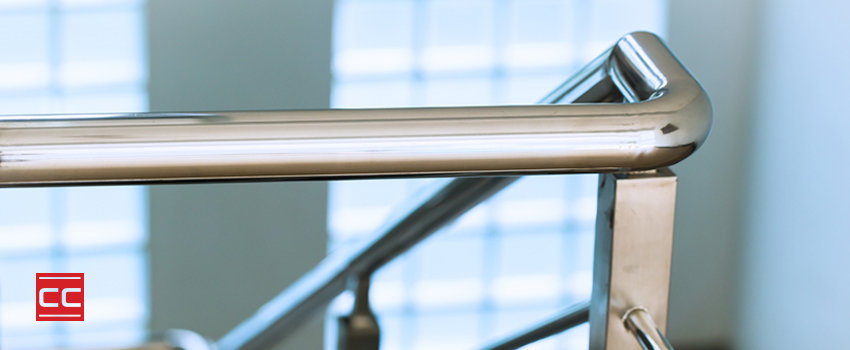
What Causes Rust on Metal Surfaces and How to Avoid Metal Deterioration
Rust on metal in a commercial space can damage a business's first impression on a visitor, whether on elevators, door handles, turnstiles, door frames, restroom partitions, fixtures, or other surfaces.
Leaving rust unchecked, even in one part of a building, can take away from its overall appearance and leave a bad impression on both employees and guests.
Not only is rust unattractive, but it also causes metal surfaces to deteriorate and break down.
To avoid rust forming on metal surfaces and hardware, it's essential to understand how it forms in the first place and what steps your team can take to protect your metal surfaces going forward.
If you're currently trying to clean up rusty surfaces, this blog will also share some of the most tried-and-trusted methods of rust removal.
Let's get started!
How rust forms on metal
Rust results from a natural process where the iron found in certain metals comes into contact with oxygen and water.
This reaction is known as oxidation, and it forms hydrated iron (III) oxide, which we see as rust.
Oxidation: iron + water + oxygen = rust
Because iron and oxygen are opposites, so they're attracted to one another, leading to oxidation.
All metals, except precious metals, will oxidize when exposed to oxygen and water. Generally, the higher the temperature the metal is stored in, the faster the rusting process.
Water and oxygen molecules are more active at higher temperatures, meaning they can more easily seep through metal surfaces and react with iron.
Rust can also form more aggressively when other chemicals, such as salt, are present.
Acids, too, can speed up the rusting process. This is because acids break down the oxide layer that covers the surface of the metal. It's then left exposed to water and oxygen, and the inevitable happens.
Rust is a problem, particularly in wet climates and coastal areas, due to the excess moisture and salt.
How to avoid rust from forming on your metal surfaces
There are many different methods for preventing rust from forming. Some of the most common of these include:
Painting
Painting is a simple and cost-effective way to protect against rust. Paint prevents rust by creating a protective barrier between the metal objects in your facility and the corrosive elements.
Oil-based paints, in particular, are a great choice to prevent water and oxygen from seeping into the metal and causing rust to form.
Powder coating
Another rust prevention method is powder coating. This is a dry finishing process created by an electric charge.
The charge causes a dry powder to fuse to the surface of the metal. This powder coating creates a barrier to protect against rust and other forms of corrosion.
Galvanizing
Galvanizing refers to applying a protective coat of zinc onto the surface of the metal.
Zinc corrodes much slower than iron, slowing the corrosion process and providing an extra layer of protection that takes much longer to rust through.
Keeping metal dry & clean
As we now know, water is a big threat to metal surfaces. Keeping metal clean and dry is one of the simplest but most effective ways to prevent rust.
If metal surfaces are in a humid area, installing a dehumidifier will help keep harmful moisture away.
Clear protecting coating
CareGuard Anti-Corrosion Coating is clear in color and covalently bonds with painted and non-ferrous metal. The top coat adds a solid layer of protection over the metal to ensure the metal is not in direct contact with air that may contain moisture and humidity that can lead to rust or corrosion.
CareGuard coatings can be applied to metal surfaces in any environment, including corporate, medical, restaurant, education, hospitality, and industrial buildings.
How to remove rust from your metal assets
Now that we know some ways to prevent rust, let's look at how to handle the problem if it's already happened. Depending on the severity of the rusting, some of these methods may work better than others. Here are five ways to remove rust:
1. White vinegar
Vinegar is one of those household items that can be used for almost anything – even rust removal.
Thanks to its acetic acid, vinegar is strong enough to dissolve rust.
Steps to remove rust with vinegar:
- Liberally spray the vinegar on the rusty area.
- Allow the vinegar to soak for at least 30 minutes.
- Scrape the rust with a wire brush, steel wool, or aluminum foil dipped in vinegar.
- Rinse the metal with water and dry thoroughly with a microfiber cloth.
2. Strip discs
Strip discs are designed to strip clean substances like rust, paint, and scale off metal surfaces.
The best thing about strip discs is that they are abrasive enough to remove rust without damaging the metal underneath. This makes them a great alternative to harsher wire abrasives.
Strip discs are generally used with angle grinders to grind off the rust.
3. Baking soda
Baking soda is doubly effective at removing rust. Firstly, it's gritty and slightly abrasive, which gives it scrubbing power to clean away rust.
Secondly, it reacts with acids like vinegar to form bubbles. These bubbles help to lift rust off metal surfaces gently.
How to use baking soda to remove rust:
- Dust baking soda over the rusted area or make a paste by mixing it with water or vinegar.
- Make sure that rusty spots are well covered
- Leave to set for one hour
- Use steel wool or a wire brush to scrub
- Rinse with water and dry thoroughly
4. Good ol' Coca-Cola
Would you believe Coca-Cola can remove rust? Thanks to its carbonation and a magical mix of phosphoric and citric acids, it can break up metal oxides without harsh chemicals. And while not as potent as commercial options, Coke is significantly less expensive – perfect for pinching pennies!
Reach for the fridge and grab some Coca-Cola: flat is better, so it doesn't fizz up immediately. Diet Coke will get you through with less sticky residue in the end. Then choose your tool–a sponge or aluminum foil, each having advantages based on how much labor versus effectiveness you want. And don’t forget afterward to clean up any residual stickiness by wiping down affected areas with soap, water, and fresh rags.
5. Rust-removing chemicals
A final method of rust removal is to use commercial rust-removing chemicals.
Since these products use harsh chemicals, they may be more effective than other DIY solutions.
However, you must be careful when dealing with heavy-duty chemicals. Make sure your team wears goggles, gloves, and protective clothing.
Don’t let the appearance of your metal surfaces tarnish your reputation
In commercial buildings, metal surfaces, and hardware are expensive decorative investments that give your space a modern and high-end appeal. Over time, these hard-working finishes take heavy abuse, often leaving them dull, tarnished, dented, scratched, and rusted.
Your existing cleaning crew can easily handle the daily cleaning and polishing. Still, to ensure these surfaces look fabulous and last as long as possible, they need special attention from experienced surface care experts.
When metal elevators, door handles, turnstiles, door frames, or architectural accents look worn, start rusting, peeling paint, or lack their original luster, it can severely affect the appearance of your building and tarnish your brand reputation.
Restore & protect your metal surfaces with Corporate Care
Protect your metal assets from corrosion with sealers & coatings
Once we have completed the rust removal and restoration work, we will buff out the surface of your metals using specialized equipment that won’t cause any damage to the surface and apply a special sealer to protect the final finish from stains and damage.
We understand how metal refinishing and corrosion prevention can help you avoid costly restoration or replacements down the line – all while improving your brand reputation.
With experience working with many different metal surface types, we understand the exact care the surfaces in your building need.
Sound like something you need in your building? Reach out to us today to learn more.
About Corporate Care – A sustainability company
Corporate Care exists to improve the appearance, performance, and longevity of every surface in the commercial buildings you manage – reducing capital expenditures, stress, and management burden on facility managers from coast to coast.
As true surface care experts, we understand the unique properties and cleaning protocols every surface needs (or doesn’t) to look amazing and comply with manufacturer warranties. We’re here to support your existing janitorial crew with cadenced deep restorative cleaning and tailored maintenance protocols – performed by IICRC®-certified cleaning technicians.
We are firm believers in restoration over replacement. Let’s reduce waste together!
